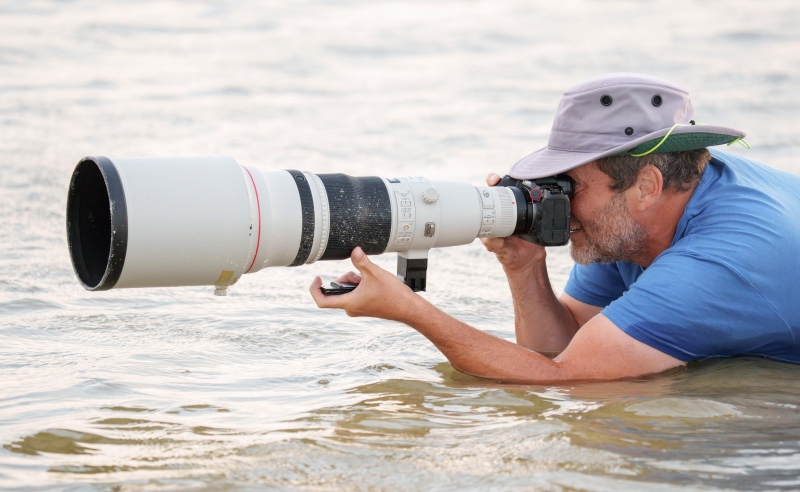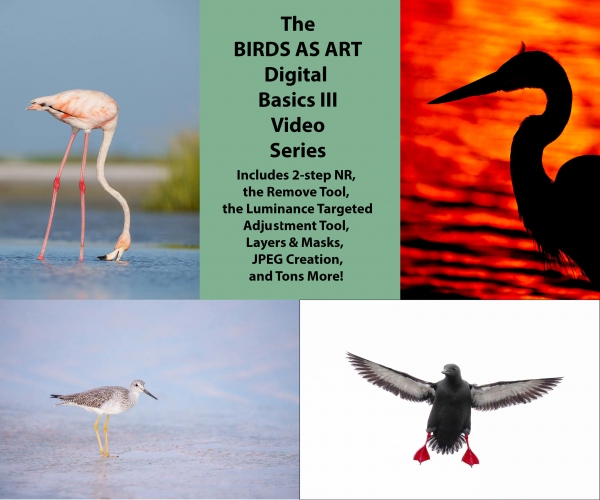What’s Up?
My chiropractor was late as usual, so I did not get to DeSoto until 5:20pm. I took a scouting walk with the 200-600 despite the mostly cloudy skies. I met a nice lady in a beach chair and later, a guy, who turned out to be her husband, Chris Vickerson. They live in Hamilton, Ontario, Canada and are immensely enjoying Florida’s tame birds.
As I headed north, the wind was from the north with a touch of west. There was a flock of about 500 American White Pelicans. And two wind surfers. I knew that I needed to get past the flock so that when they took off they would be flying at me for a bit, at least until they turned to the east to get where they were going. Anyhoo, I didn’t make it. The wind surfers scared off the entire flock while I was far out of position.
Later on, Chris and I worked a mixed flock of terns, shorebirds, gulls, and a single young Roseate Spoonbill. He was thrilled with the spoonie, I was thrilled with the half dozen or so Caspian Terns. Last was a glorious sunset.
Today is Tuesday 31 October 2023. I will be headed to the DeSoto early. Wherever you are an whatever you are doing, I hope that you too have a great day.
Please remember to use the B&H and Amazon links that are found on most blog pages and to use the BIRDSASART discount code at checkout when purchasing your new gear from Bedfords to get 3% back on your credit card and enjoy free second-day air FedEx. Please, also, consider joining a BAA IPT. You will be amazed at how much you will learn!
You can find some great photo accessories (and necessities, like surf booties!) on Amazon by clicking on the Stuff tab on the orange/yellow menu bar above. On a related note, it would be extremely helpful if blog-folks who, like me, spend too much money on Amazon, would get in the habit of clicking on the Amazon logo link on the right side of each blog post when they shop online. As you might expect, doing so will not cost you a single penny, but would be appreciated tremendously by yours truly. And doing so works seamlessly with your Amazon Prime account.
If an item — a Delkin flash card, or a tripod head — for example, that is available from B&H and/or Bedfords, is also available in the BAA Online Store, it would be great, and greatly appreciated, if you would opt to purchase from us. We will match any price. Please remember also to use my B&H affiliate links or to earn 3% cash back at Bedfords by using the BIRDSASART discount code at checkout for your major gear purchases. Doing either often earns you free guides and/or discounts. And always earns my great appreciation.
|
|
|
This image was created on 30 October 2023 at Fort DeSoto Park IPT. I used the handheld Sony FE 200-600mm f/5.6-6.3 G OSS lens (at 338mm) and The One, the Sony Alpha 1 Mirrorless digital camera. ) The exposure was determined using Zebra technology with ISO on the Thumb Dial. ISO 8000: 1/500 second at f/6.3 (wide open). RawDigger showed the exposure to be perfect. AWB at 6:37:28pm just after the sun disappeared behind a large cloud bank on the western horizon. Tracking: Expand Spot AF-C with Human Face/Eye Detection performed perfectly. Be sure to click on the image to enjoy a larger, sharper, high-res version. Image #1: Chris Vickerson down and dirty with his Canon 600mm f/4 and an R5.
|
What was Chris Doing Right and Wrong?
What was Chris doing right? I am thinking on one very obvious thing.
What was Chris doing wrong? I am thinking of two things.
|
|
The BIRDS AS ART Digital Basics III Video Series |
Coming Soon!
Note that when you are being lazy and working with a relatively slow lens (f/6.3), you need to use very high ISO settings. I will be covering my new 2-step noise reduction techniques in the upcoming Digital Basics III Video Series.
Over the past few months, I have added lots of great new stuff to my digital workflow: Color Mixer basics and the more sophisticated Saturation Targeted Adjustment Tool, 2-Step Noise Reduction, and the Remove Tool. With these changes and other improvements, I had been considering creating a Digital Basics III PDF. But recently, I realized that creating a series of videos would be a lot simpler and would make learning a lot simpler for most folks. In addition, videos will allow me to delve more deeply into the fine points of using the new (and previously used) Photoshop Tools. Each video will include two complete image optimizations, from soups to nuts. I am hoping to get the first two videos done this coming weekend. Thus, details on the BIRDS AS ART Digital Basics III Video Series should be available in early November.
Typos
With all blog posts, feel free to e-mail or to leave a comment regarding any typos or errors.
















Never swim with your long lens unless you’re a trained Navy Seal. Support the lens by the lens barrel not the lens foot. Focusing with just a thumb while holding the lens foot is not the best way to acquire fast focus. Keep sun angle in mind for lighting and shadows but caption says cloudy so just a reminder as what little shadow showing on the water doesn’t seem to be towards his subject. Always have a spare set of clothing or buy better waterproof scuba gear. Don’t forget a snorkel. Tip o’ the cap to a man wanting to get his shot. May it be a Calender cover!
Just for the record books, if you have a lens that offers DMF (Direct Manual Focus), turning the manual focus ring when the AF system is completely blind can be a godsend. I wish the 200-600 had it.
I am pretty sure that Chris is relying on AF.
with love, artie
Good? Hopefully getting an eye level shot by getting down low..
Bad? Would have been better served by sitting or laying in a knee (or other part) position as it will be difficult to rise from the prone position without dumping the lens in the drink…using Canon rather than Sony (Art)… Using a heavy Canon f/4 + tc (around 7#) rather than a Nikon 800 f/6.3 (5.25#) (Adam)
He is young and spry. As opposed to me; but that does’t stop from from sitting in a foot of water and having to get up. My prone days are long gone. Prone is much better for following action as you are working through the viewfinder. As far as weight is concerned, you conveniently forgot to mention that the Z9 weighs nearly 3 whole pounds! The a1 is a shade less than half of that.
with love, a
Good-down low
Bad-better to gain more stability by having left hand on the barrel of the lens.
Excellent.
a
Hi Artie
What was Chris doing right?
-Getting low and taking the shot (If it is a shore bird)
What was Chris doing wrong? I am thinking of two things.
1. Put his finger to the focus ring
2. Not using enough support for the lens.
Cheers
Nonis
Not sure about 1. Otherwise correct.
a
Arthur Morris would say: The thing he is doing wrong the most is shooting Canon and not Sony like Arthur said he should.
That is what I would say 🙂
a
Image #1 Chris Vickerson with his Canon 600mm f/4 and an R5 is interesting! That is a giant picture worker form!
Doing right: getting low.
Doing wrong: hand-holding a 12 pound lens six inches above the water by the tripod foot.
With all blog posts, feel free to e-mail or to leave a comment regarding any typos:
What was Chris doing wrong? I am thinking of to things.
Of doing wrong, which are you objecting to: having the lens do close to the water or holding the lens by the foot?
with love, artie
ps: looks as if Jim caught my typo. Many thanks for that.
It’s not that the lens was close to the water, just that a lens that size being held close to the water is a recipe for disaster. A better platform is needed if you’re going to shoot like that.
Let’s see…
For me, the obvious correct thing is that he’s gotten low. I’ll assume low was correct for the situation.
As for incorrect I’ll go with:
1 – Supporting the lens with the foot isn’t as stable as cupping the barrel.
2 – Hmmm. This may be a stretch, but how about using the rear screen instead of the viewfinder to reduce neck strain and fatigue.
Excellent, but if I were lying prone I would want my eye to the viewfinder. 100% of the time. To better stay on moving birds.
with love, artie